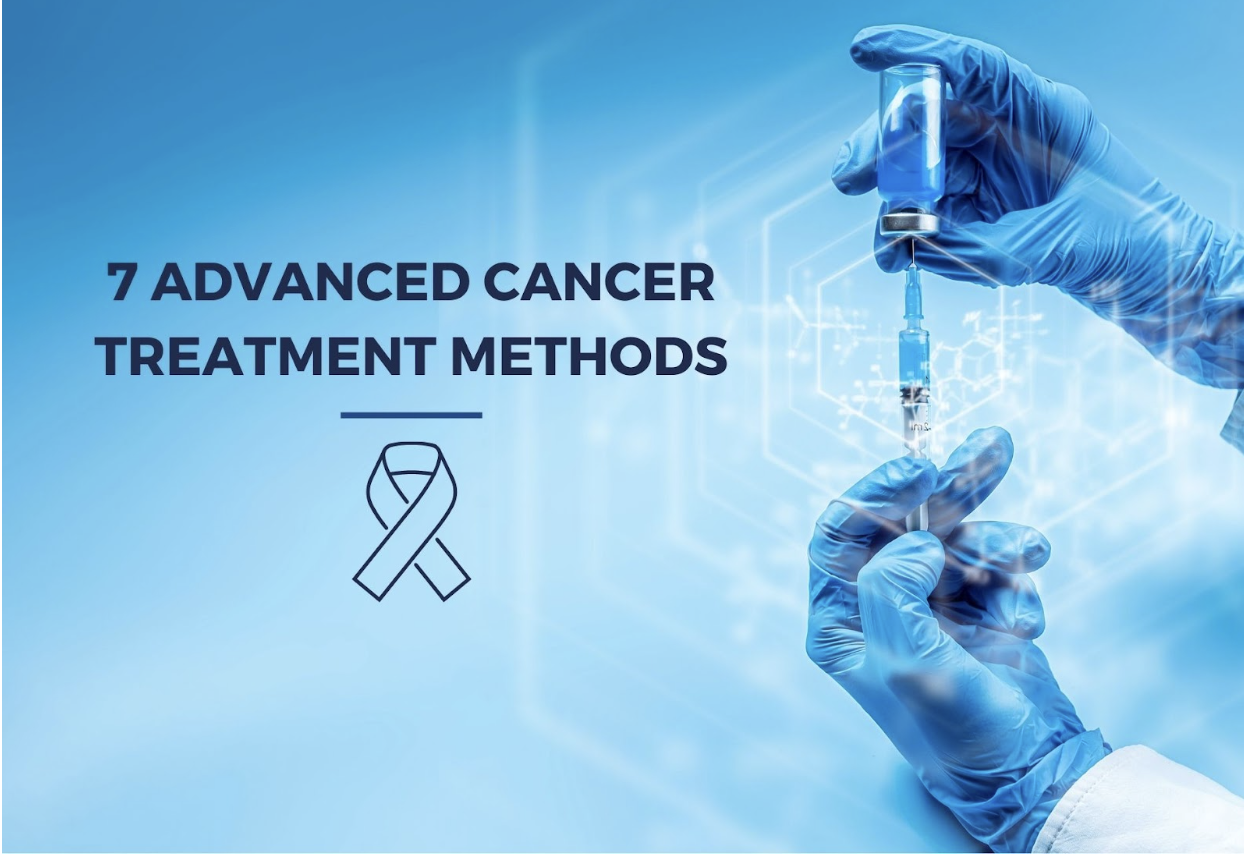7 Advanced Cancer Treatment Methods
Being diagnosed with advanced cancer may be daunting. The term “advanced cancer” refers to a malignancy that is difficult to treat. This does not, however, rule out the prospect of therapy being an option. The treatment will cut cancer’s development, size, and symptoms to prolong your life.
You may learn more about advanced cancer therapy using the resources on this page.
What Is Advanced Cancer?
If cancer spreads or reappears after treatment, it’s considered advanced and unlikely to be cured.
In most cases, advanced cancer cannot be cured but can be managed. Palliative care is a kind of therapy whose goal is to make the patient’s life as comfortable and pain-free as possible. Cancer treatment may shrink tumors, halt disease spread, and lessen side effects.
When Deciding on a Course of Therapy, What Factors Do You Consider?
Having cancer return and spread may be unpleasant and stirs many negative emotions. Give yourself time to absorb what’s occurring and act responsibly.
Deciding whether to undergo therapy for cancer that has spread to the bone, lymph nodes, or other organs may be tricky.
1. Analyze Each Alternative Thoroughly Before Making a Final Decision
You must understand the problem, potential remedies, and probable side effects. After that, you may assess your options and reach a comfortable conclusion.
2. Make a Note of the Facts
A diagnosis of advanced cancer may be devastating. Also, it’s possible that you won’t recall everything you have been told by the physician. Taking notes or having a friend or family attend appointments with you might be helpful.
3. How Should You Proceed if You Have a Query?
Don’t hesitate to consult your doctor if you have any questions or concerns. Before your visits, you may wish to make a list of questions to ask.
4. Take a Second Look at the Situation
Sometimes you may want to get a second opinion from a different medical professional. It is a matter of your health, so there is nothing wrong with looking for a second opinion.
5. Talk About the Many Therapy Options Available
Sharing your options with family or your doctor may help you make treatment selections. You can brainstorm with your FNF and physician to find a reliable solution.
Effective Advances in Cancer Treatment Methods
1. Immunotherapy
Immunotherapy works by enhancing the body’s natural defenses against cancer. A new study suggests immunotherapy may heal even the most advanced, hard-to-treat malignancies.
Despite promising results, researchers are still studying immunotherapy.
However, FDA-approved drugs are used to treat certain malignancies. Immunotherapy has provided various therapeutic options for patients and is some’s primary treatment. IV infusions are used to give immunotherapies.
2. Cancer and Nano Diamonds
Researchers at UCLA’s Jonsson Comprehensive Cancer Center have created a new drug delivery method. In that process, nanodiamonds are used to carry chemotherapy chemicals directly into brain tumors.
Nanaodiamonds fall into the category of artificial diamonds. Artificial or lab grown diamonds are less harmful to the environment as they are not mined. To escape the blood-diamond connotation, there has been global approval for this gem. Instead of being just a jewel, these diamonds are being used in various applications today.
Nanodiamonds are made by detonating synthetic diamonds or grinding real diamonds into powder. They are highly compatible with biological systems which is a new kind of carbon particle.
They can bind and transport biocompatible medications, imaging agents, nucleic acids, and proteins. It is possible because of their flexibility. Also, commercial production of this product may be scaled relatively simply.
Unlike diamond jewelry, 5 nm nanodiamonds can be mass-produced for less money. These lab grown diamonds will be made using carbon-containing explosives.
To create ultrananocrystalline nanodiamond particles (1-150nm), high-pressure, high-temperature processing is required. The way a nanodiamond is made affects its size, shape, and surface quality.
These characteristics may then be tweaked to suit a particular application. Cancer therapy uses nanodiamonds as medication delivery vehicles and imaging sensors.
Eighty-four studies on nanodiamonds in cancer therapy and diagnostics have been published. Several studies have combined nanodiamonds with doxorubicin, paclitaxel, or cisplatin. Nanodiamond-mediated cisplatin injection and intracellular release reduced human cervical cancer cell proliferation.
Surgery
Oncology surgeons can remove most malignancies, excluding blood tumors. The treatment is best for early-stage cancers that haven’t spread. However, it is also a welcome treatment for those with advanced cancer types to relieve discomfort and lessen the pain.
Lung Cancer Lobectomy Using Video-Assisted Thoracoscopy
A lobectomy is a surgical procedure. In this process, the cancerous tissue from the lung is removed in its entirety. Lung cancer patients may recover faster with general anesthesia and VATS lobectomy.
A thoracoscope with a light and camera is inserted via a tiny incision. Special instruments are used to remove the damaged lung tissue.
Surgery for Cervical Cancer
28,000 new instances of cervical cancer are detected each year in the U.S, as per research. Open surgery reduces cancer recurrence and increases disease-free life.
Radiotherapy
An additional therapeutic option for cancer patients is radiation therapy. More accurate, effective, and individualized radiation may now treat early and advanced cancers.
Metastatic Cancer: SABR (Stereotactic Ablative Radiation)
According to studies, patients who got SABR and regular medication have a higher survival rate.
SABR for Lung Cancer in the Early Stages that Are Inoperable
SABR is an option for people who aren’t good candidates for surgery. In a study of 273 patients, this method was shown to be a very effective and well-tolerated local control.
-
Targeted Therapies
Oncologists use targeted, precision medicine therapies to personalize patient care. The genetic profile of a tumor or blood sample is determined by testing. Doctors may now target cancer-causing genes with medications.
Oral or injectable medications may destroy or halt cancer cell growth. Targeted therapies are used for tumor prevention and recurrence prevention.
The HER2 gene plays a role in breast cancer cell proliferation and is evaluated in patients.
An immunotherapy trial for patients with HER2-positive breast cancer has progressed. HER2-positive breast cancer patients will benefit from the diamond research. It is a study on various types of diamonds to improve current therapy options.
A subset of patients in the Diamond trial has previously received Trastuzumab. But their condition has deteriorated since treatment began. The addition of two more immune-boosting medications may improve the trial’s findings.
Hormone Therapy
As an advanced cancer treatment, it may be used to slow or halt the progression of the disease. Therefore, improving the patient’s quality of life and extending their lives.
Combination Therapies
“Combination therapy” combines two cancer-fighting methods. Traditional chemotherapy is being supplemented with newer, more effective medicines.
This method is likely to become the standard of therapy for certain cancers. Tecentriq and Avastin have recently been used in treating liver cancer as an example.
Active Surveillance
For certain kinds of cancer, active surveillance may be all that is required. Your doctor may recommend this therapy if your cancer is still in its early stages and progressing slowly or not at all.
However, prostate cancer grows relatively slowly and is commonly treated with active monitoring. Medical specialists evaluate symptoms and PSA levels. And blood tests are used to keep track of the patients. Further treatment options are considered if symptoms appear or tests show cancer progression.
A patient who has exhausted all other treatment choices and wants a break from their medication may choose surveillance.
Supportive Care
Supportive care reduces the physical and emotional toll of cancer treatment. Psychotherapy and massage treatment may help patients cope with a diagnosis. Acupuncture relieves pain, while dietary advice helps patients maintain a healthy weight.
Conclusion
Efforts to improve cancer treatment and diagnostic methods are continuing. Even if you have advanced cancer, experimental medicines are approved every year.
You will have a higher chance of surviving and remission as medical technology improves. You may benefit from attending a cancer support group to boost your mental health and resilience.





